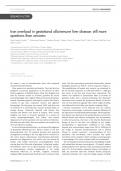DOI: 10.1002/pd.3887
RESEARCH LETTER
Iron overload in gestational alloimmune liver disease: still more
questions than answers
Serge Vanden_Eijnden1,2*, Mohammad Hassoun1, Catherine Donner2, Frédéric Cotton3, Domenico Girelli4, Nicky D’Haene5, Julie Désir6 and
Marie Cassart7
1
Neonatal Intensive Care Unit, CHU Charleroi, Charleroi, Belgium
2
Fetal Medicine Department, ULB-Erasme Hospital, Université Libre de Bruxelles, Brussels, Belgium
3
Clinical Chemistry, ULB-Erasme Hospital, Université Libre de Bruxelles, Brussels, Belgium
4
Department of Medicine, University of Verona, Verona, Italy
5
Pathology Department, ULB-Erasme Hospital, Université Libre de Bruxelles, Brussels, Belgium
6
Medical Genetics Department, ULB-Erasme Hospital, Université Libre de Bruxelles, Brussels, Belgium
7
Radiology Department, ULB-Erasme Hospital, Université Libre de Bruxelles, Brussels, Belgium
*Correspondence to: Serge Vanden_Eijnden. E-mail: svdeijnd@ulb.ac.be
Funding sources: None
Conflicts of interest: None declared
We report a case of monochorionic twins with suspected twins. The liver parenchyma presented characteristic marked
neonatal hemochromatosis. hyposignal intensity on both T1 and T2 sequences (Figure 1).
Their parents are unrelated and healthy. They had lost two The quantification of hepatic iron content was estimated by
daughters in previous pregnancies, in the absence of other the use of adult sequences at 12 300 and 10 600 (+/ 2800) g/g
history suggestive of familial disease. Their first daughter was liver tissue, in the first and second twin, respectively. The
born by cesarean section at 35 weeks’ gestation for ascites mother was admitted in spontaneous labor at 33 weeks of
and cardiomegaly. She weighed 3250 g and presented hydrops, gestation, 6 days after a normal monitoring. The obstetrical
anemia, thrombocytopenia, and hepatic cytolysis. She died at ultrasound scan revealed the unexpected demise of the first
1 month of age from respiratory distress and digestive twin. He was delivered vaginally with a birth weight of 2400 g,
hemorrhage. Her karyotype was normal, 46XX, and there was soon followed by his healthy twin brother weighing 2100 g.
no evidence of in utero infection, immune hydrops fetalis, or External examination of the demised twin was normal.
storage disease. Cholestatic hepatitis with hepatic iron Postmortem macroscopic examination disclosed dilatation of
overload and fibrosis were found at autopsy. Their second the right heart and mild hepatosplenomegaly. Microscopically,
daughter was born at 30 weeks’ gestation in a context of iron deposit was observed in the periportal spaces of the liver
ascites, hepatosplenomegaly, liver failure, and anemia without fibrosis and without extrahepatic iron accumulation
diagnosed at 25 weeks’ gestation with no evidence of infection. in either the pancreas, the heart, or the thyroid. Biochemical
She died soon after birth. Iron accumulation was found in the dosage of iron in the liver was 4 600 g/g of dry weight,
liver and thyroid at autopsy. corresponding to approximate 13 800 g/g of wet weight
In view of this gestational history, we advanced the diagnosis (hepatic iron concentration ranges from 240 to 38 000 g/g of
of gestational alloimmune liver disease (GALD) at the first dry weight in neonatal hemochromatosis and is around
preconceptional visit. We planned prenatal and postnatal 250 g/g in normal neonates).1 Immunostaining of liver
management according to the very high risk of recurrence of specimens with anti-human C5b-9 revealed very sparse
this severe disease. Spontaneous monochorionic–diamniotic membrane attack complexes (MAC) staining, occurring mainly
gestation was diagnosed at 11th week’s scan. We treated the in macrophages. The cause of death could not be identified.
mother with weekly intravenous immunoglobulins (IVIG) The surviving boy presented mild anemia (hemoglobin 10 g/dl)
starting from the 18th week of gestation (1 g/kg body weight). with normal liver function (serum glucose >2.5 mmol/l, alanine
Until delivery, there was no sign of hydrops, ascites, anemia, aminotransferase 5 U/l, albumin 31 g/l, international normalized
or monochorionic vascular complication at the weekly ratio 1.37). He had neither respiratory distress nor hydrops. At
ultrasound follow-up. At 29 weeks, magnetic resonance birth, he presented mild iron overload (ferritin 525 ng/ml,
imaging (MRI) demonstrated frank liver iron overload in both transferrin saturation 34%, total iron biding capacity 212 g/dl)
Prenatal Diagnosis 2012, 32, 1–3 © 2012 John Wiley & Sons, Ltd.




